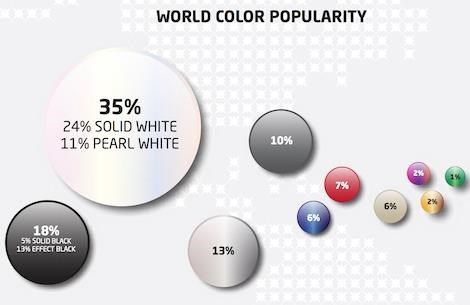Global Automotive 2015 Color Popularity Report
White overtook silver in 2011 as the most preferred vehicle color preference; since then, white has continued to gain popularity on all vehicle types in most regions.

White has continued to increase in popularity, topping out this year as the number one color globally, according to Axalta Coating Systems’ Automotive Color Popularity Report. This report looks at automotive color popularity by global geography and by a variety of vehicle segments.
White overtook silver in 2011 as the most preferred vehicle color preference. Since then, white has continued to gain popularity on all vehicle types in most regions, while silver has continued to decline. Customers in Asia (41 percent) and Africa (46 percent) prefer white more than in other parts of the world.
Since 1953, white has been one of the top five colors during all but three years. Whites have evolved and today they are available in a rich variety of alternatives from stone white solids and vanilla shades, to cool bright whites and pearlescent whites.
After white at 35 percent, there is a big drop to black, the next most popular color at 18 percent. These are followed by silver at 13 percent, gray at 10 percent, red at seven percent, and blue and beige/brown tied at six percent. At the least popular end of the spectrum, yellow was found on only two percent of vehicles, green on one percent, and all other colors on two percent of vehicles.
While the neutrals of white, silver, gray and black dominate, red and blue continue to be the top colorful choices, with red especially winning over vehicle buyers.
Related Content
-
EPSI Relaunches Custom Masking Program
EPSI’s plotter cutting provides custom solutions for complicated masks and irregular shapes.
-
Can You Afford to Not Use Custom Masking?
Are you weighing the costs of a custom masking solution vs. an off-the-shelf solution? Christy Schulthess of Custom Fabricating & Supplies discusses the overall savings that can be realized with custom masking.
-
Masking Solutions for Medical Applications
According to Custom Fabricating and Supplies, a cleanroom is ideal for converting, die cutting, laminating, slitting, packaging and assembly of medical-grade products.















